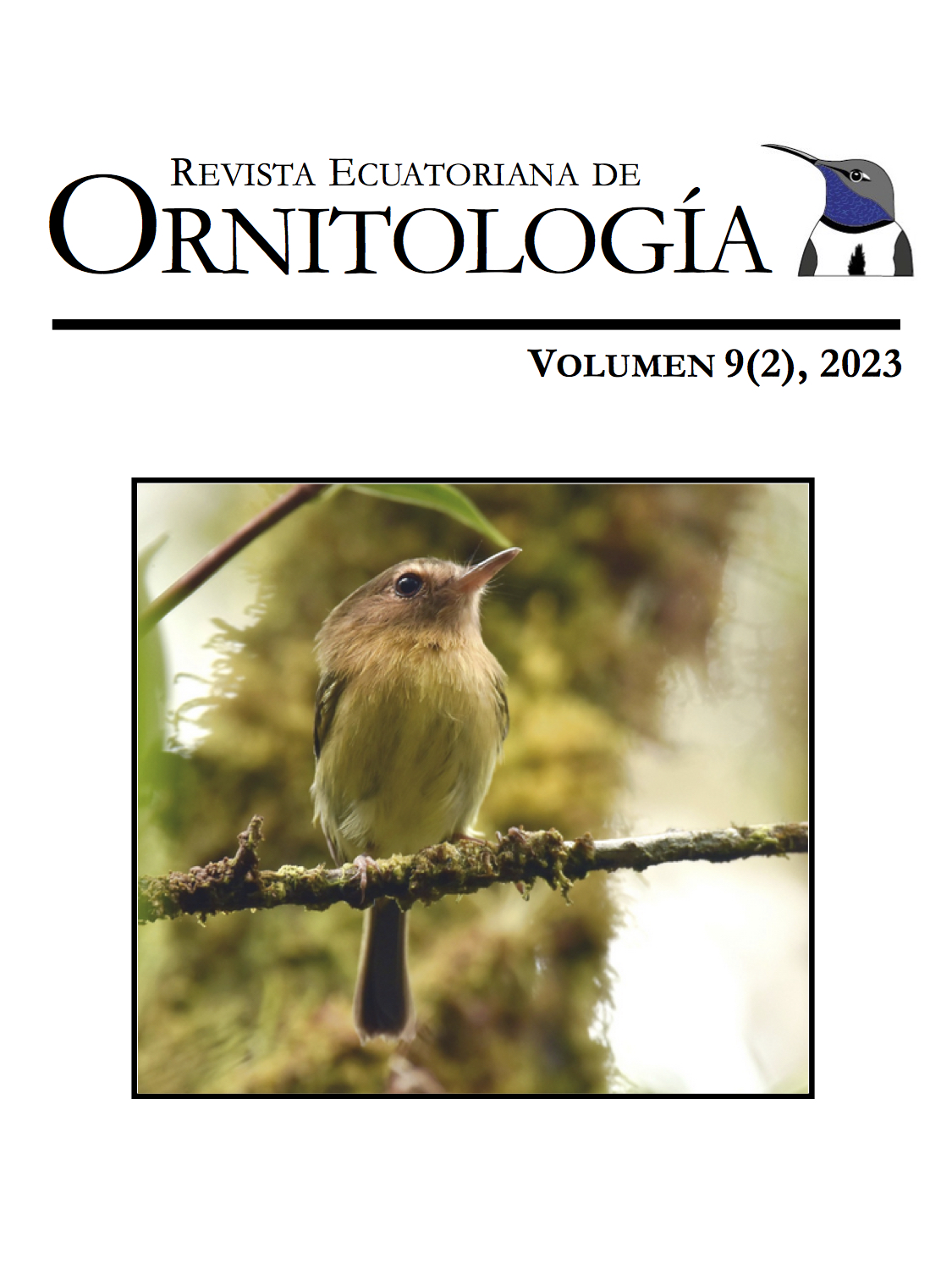FOUR CASES OF DIFFERENT PLUMAGE CHROMATIC ABERRATIONS IN GALAPAGOS BIRDS
DOI:
https://doi.org/10.18272/reo.v9i2.2776Keywords:
colour aberrations, leucism, brown, ino, plumageAbstract
Plumage chromatic aberrations usually represent a problem for field ornithologists. Chromatic aberrations are originated by genetic mutations that result in a pigment deficiency, drastically altering the typical colour of individuals, and can vary both within and between species. Here, we present four different colour aberrations in four bird species native and endemic to the Galapagos Islands: Lava Gull Leucophaeus fuliginosus, Brown Noddy Anous stolidus, Floreana Mockingbird Mimus trifasciatus, and Small Ground Finch Geospiza fuliginosa. These records expand taxonomically the occurrence of chromatic aberrations on Ecuadorian birds and in the Galapagos archipelago.
Downloads
References
Cadena-Ortiz, H., Bahamonde-Vinueza, D., Cisneros-Heredia, D.F., & Buitrón-Jurado, G. (2015). Alteraciones de coloración en el plumaje de aves silvestres del Ecuador. Revista Avances en Ciencias y Tecnologías, Sección B, 7(2), B75–B90. DOI: https://doi.org/10.18272/aci.v7i2.259
Ducatez, S. & Devore, J. (2023). Observation of a leucistic brown noddy (Anous stolidus) in Tetiaroa, French Polynesia. Marine Ornithology, 51, 23–25. URL: http://www.marineornithology.org/article?rn=1505
Grace, J. K., Tompkins, E. M. & Anderson, D. J. (2013). Leucistic adult Large Cactus-Finch (Geospiza conirostris) on Española Island, Galapagos: A potential continuation of nestling beak color. Wilson Journal of Ornithology, 125(1), 201–204. DOI: https://doi.org/10.1676/12-093.1
Manga, P., Kromberg, J. G. R., Box, N. F., Sturm, R. A., Jenkins, T. & Ramsay, M. (1997). Rufous oculocutaneous albinism in South African blacks is caused by mutations in the TYRP1 gene. The American Journal of Human Genetics, 61, 1095–1101. DOI: https://doi.org/10.1086/301603
Ortiz-Catedral, L. (2018). Reintroduction plan for the Floreana mockingbird (Mimus trifasciatus) 2017-2025. Auckland, New Zealand: Massey University.
Sage, B. L. (1962). Albinism and melanism in birds. British Birds, 55, 201–225. URL: https://britishbirds.co.uk/wp-content/uploads/article_files/V55/V55_N06/V55_N06_P201_225_A033.pdf
van Grouw, H. (2006). Not every white bird is an albino: sense and not sense about colour aberrations in birds. Dutch Birding, 28, 79–89. URL: https://dofvsj.dk/images/dokumenter/bestyrelse/ArtiklerFaunistik/Dutch_Birding_28279-89_2006.pdf
van Grouw, H. (2021). What’s in a name? Nomenclature for colour aberrations in birds reviewed. Bulletin of the British Ornithologists Club, 141(3), 276–299. DOI: https://doi.org/10.25226/bboc.v141i3.2021.a5
Withgott, J. H. & McMahon, J. A. (1993). General notes. Conspecific harassment of a leucistic Barn Swallow. Bulletin of Oklahoma Ornithological Society, 26, 38–39.
Downloads
Published
How to Cite
Issue
Section
License
Copyright (c) 2023 Enzo Reyes, Luis Ortiz-Catedral

This work is licensed under a Creative Commons Attribution-NonCommercial 4.0 International License.
Los autores que publiquen en la Revista Ecuatoriana de Ornitología aceptan los siguientes términos:
- Los autores/as conservarán sus derechos de autor y garantizarán a la revista el derecho de primera publicación de su obra, el cuál estará simultáneamente sujeto a la Licencia de Reconocimiento No Comercial de Creative Commons.
- Los autores/as podrán adoptar otros acuerdos de licencia no exclusiva de distribución de la versión de la obra publicada, pudiendo de esa forma publicarla en un volumen monográfico o reproducirla de otras formas, siempre que se indique la publicación inicial en esta revista.
- Se permite y se recomienda a los autores difundir su obra a través de Internet en su repositorio institucional, página web personal, o red social científica (como ResearchGate o Academia.edu).


